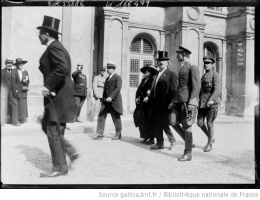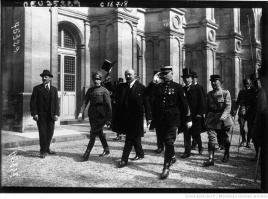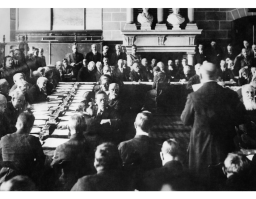Introduction↑
The Treaty of Saint-Germain formally confirmed the dissolution of the Austrian state (unofficially called “Cisleithania”), which had been a political reality since November 1918. A separate treaty was signed with Hungary on 4 June 1920 in the Grand Trianon palace. The Austrian national assembly (Nationalrat) accepted the terms of the treaty on 6 September 1919, with protest, mainly against the territorial conditions. The ratification by the parliament followed on 17 October 1919. The Treaty of Saint-Germain took effect on 16 July 1920.
Negotiating the Treaty↑
The national assembly passed a detailed territorial program on 22 November 1918. The Austrian delegation, under the leadership of Chancellor Dr. Karl Renner (1870-1950), a social democrat, arrived in Paris in May 1919. The territorial program of the Austrian delegation claimed all regions of the former Dual Monarchy in which the majority of the population were German speaking according to the last official census of 1910. This area amounted to 118,311 km² and a population of 10.37 million inhabitants, and also included border regions and three enclaves in Bohemia, Moravia, and Austrian Silesia (today the Czech Republic). The claim on regions in western Hungary, including the city of Pressburg (Pozsony/Bratislava), was raised on the basis of national self-determination, since they were not part of the Austrian state prior to 1918.
On 2 June 1919, the first draft of the peace treaty was presented to the Austrian delegation, which in turn submitted a formal note of protest against the ban of the proposed union with Germany. Additionally, a demand was raised regarding the inclusion of territories in western Hungary. The third and final draft of the treaty was handed over to the Austrian delegation on 2 September 1919. In regard to the border with Hungary, it reversed the conditions in favor of Austria.
Controversy: Anschluss↑
The Austrian delegation understood itself as representing a state that was a federal entity of the new Weimar Republic. Austrian foreign minister and social democrat Otto Bauer (1881-1938) argued that Austria would not be able to survive on its own, and that a federation with the other successor states of Austria-Hungary was not possible in the foreseeable future. In order to avoid economic and social turmoil and achieve national self-determination, integration into Germany (”Anschluss“) was, therefore, the only option, according to Bauer.
By the end of World War I, this position met with almost no opposition from the Austrian public, although with the internal destabilization and social polarization in Germany in 1919 there were some dissenters, like future chancellor and Christian social politician Ignaz Seipel (1876-1932). An unofficial plebiscite, held in the federal province of Vorarlberg on 11 May 1919, showed a majority of 81 percent of votes in favor of joining Switzerland rather than Germany. In Switzerland, however, this initiative met with very little support, since protestant and French politicians feared it would lend more influence to their Catholic and German co-nationals. The Swiss army also voiced concerns about having to extend its defense system beyond the Rhine river.
The German government did not openly argue for the Anschluss, although some political circles (like the Social Democratic Party and the German Democratic Party) strongly favored this scenario. There were even plans to unite Austria with Bavaria, either as a strong federal state of Catholic character within the Weimar Republic, or as a fully independent state. The Allied leaders, however, also had different opinions about the Anschluss among themselves. US Secretary of State Robert Lansing (1864-1928) would have accepted the union of Austria and Germany, and Italy also did not have major objections at the very beginning. The main opposing force was France, who feared that Germany would gain too much in terms of resources and geopolitical weight. Hence, the peace treaty insisted on the lasting sovereignty of Austria as an independent state unless the approval of the Council of the League of Nations was achieved (in German and Austrian historiography, this was called the “Anschlussverbot”). In accordance with this provision, the national assembly passed a separate law on 21 October 1919 that officially changed the name of the state from "Republic of German-Austria" (Republik Deutschösterreich) to "Republic of Austria" (Republik Österreich).
Details of the Treaty↑
The peace treaty of Saint-Germain contained 381 articles, which included a ban on introducing compulsory military service, and set an upper limit for the professional army of 30,000 men in service. Arms factories were also banned, and Austria was obligated to pay reparations for war damage, which were to be determined by a special commission of the Allied states (this actually happened in 1921). It also included regulations on the League of Nations.
As compared to the territorial program of the Austrian government, some territories remained detached. Italy officially gained the Val Canale/Kanaltal and a substantial part of the former crown land of Tyrol, which was divided not along the linguistic boundary, as Woodrow Wilson’s (1856-1924) Fourteen Points had suggested, but instead along the main mountain passes in the Alps. Two minor areas of southern Carinthia (the valley of the Mieß/Meža with the city of Unterdrauburg/Dravograd and the community of Seeland/Jezersko) were to be ceded to the Kingdom of Serbs, Croats, and Slovenes (SHS). The Treaty of Saint-Germain also stipulated that Lower Styria (formerly southern Styria), where the Austrian state laid claim to the region of Marburg/Maribor, was likewise to become part of the South Slav state. The borders with Czechoslovakia were mostly identical with the historic boundaries of Upper and Lower Austria, with adjustments in favor of Czechoslovakia for infrastructural reasons (railway junctions) or Czech minorities (around Gmünd/České Velenice and Feldberg/Valtice).
According to the treaty, two consequent plebiscites were to be held in two zones of the Klagenfurt basin. Here, the occupation by SHS troops in July 1919 had resulted in paramilitary activities that were soon labelled “resistance combat” (Abwehrkampf) – a development that is still the object of conflicting interpretations between Carinthian and Slovene historians. In zone A, where according to the census of 1910, 70 percent of the population used Slovene as their language of everyday communication, the plebiscite took place on 10 October 1920. With a turnout of over 95 percent, 59.04 percent were in favor of Austria and only 40.96 percent voted for the South Slav kingdom. Accordingly, the plebiscite in zone B was cancelled and zone A remained under Austrian sovereignty.
The Hungarian government opposed the stipulations of the treaty of Saint-Germain and supported right wing paramilitary troops to prevent the Austrian state from taking over the region in April 1921. After fighting and some atrocities, both governments reached a compromise in the Venice agreement of 13 October 1921: Hungary agreed to end the paramilitary violence and let the Austrian administration take over most of the territory that would become the federal province of Burgenland. The area around its designated capital, Ödenburg/Sopron, would remain under Hungarian administration until a plebiscite decided its future. The plebiscite was held between 14 and 16 December 1921 under conditions that are still controversial. With almost 89 percent turnout, a majority of 63.4 percent favored integration into Hungary and 34 percent favored Austria (the remaining votes cast were invalid).
Peter Haslinger, Herder-Institut für historische Ostmitteleuropaforschung - Institut der Leibniz-Gemeinschaft
Section Editor: Tamara Scheer
Selected Bibliography
- Ackerl, Isabella / Neck, Rudolf (eds.): Saint-Germain 1919. Protokoll des Symposiums am 29. und 30. Mai 1979 in Wien, Munich 1989: Oldenbourg.
- Gerwarth, Robert: The vanquished. Why the First World War failed to end, 1917-1923, London 2016: Allen Lane.
- Kerekes, Lajos: Von St. Germain bis Genf. Österreich und seine Nachbarn, 1918-1922, Budapest 1979: Akad. Kiadó.
- Koch, Klaus / Rauscher, Walter / Suppen, Arnold (eds.): Außenpolitische Dokumente der Republik Österreich 1918-1938. Selbstbestimmung der Republik, 21. Oktober 1918 bis 14. März 1919, volume 1, Vienna 2015: Verlag der österreichischen Akademie der Wissenschaften.
- Konrad, Helmut / Maderthaner, Wolfgang (eds.): Das Werden der Ersten Republik. ...der Rest ist Österreich, Vienna 2008: Gerold.











